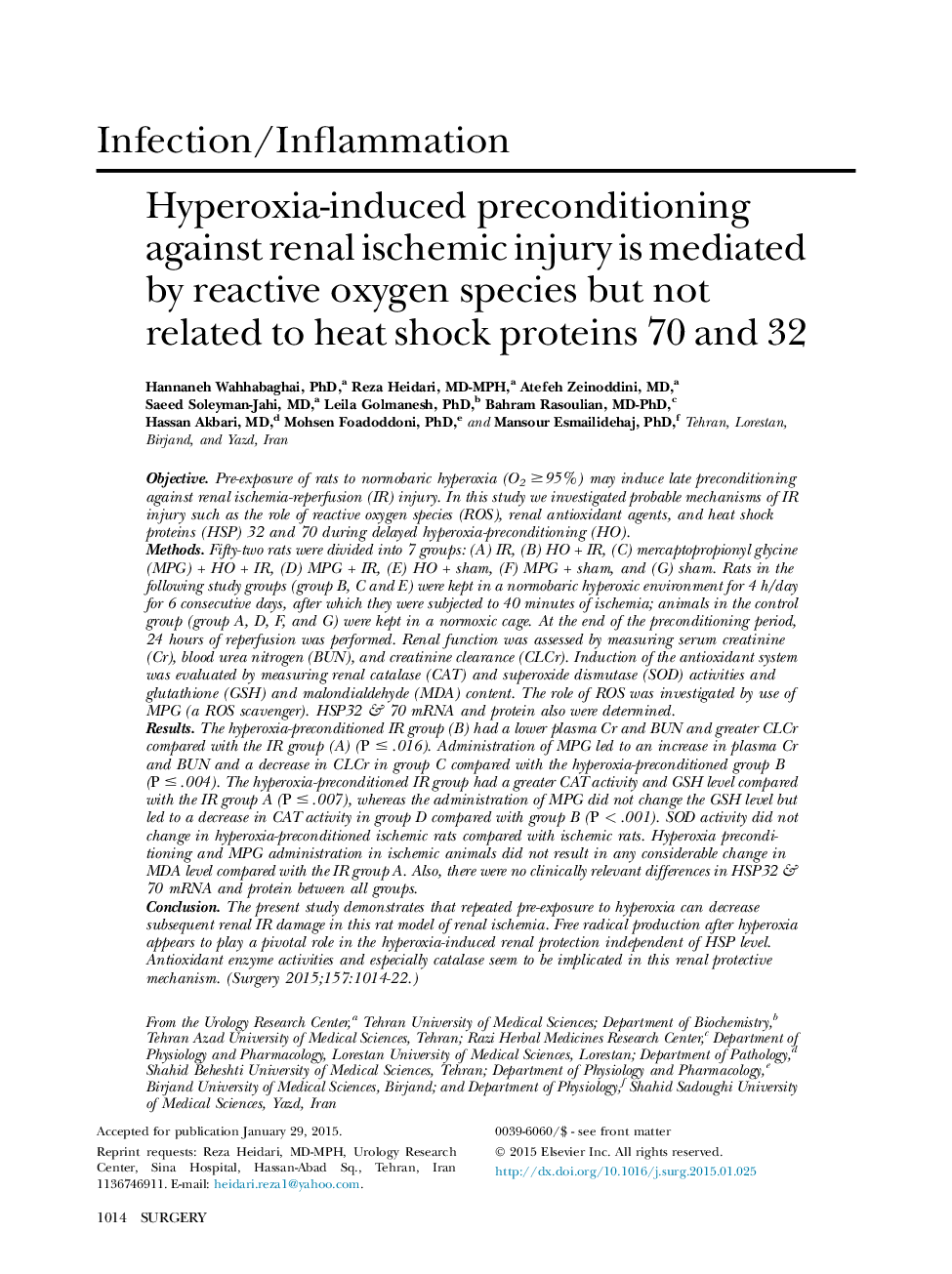| کد مقاله | کد نشریه | سال انتشار | مقاله انگلیسی | نسخه تمام متن |
|---|---|---|---|---|
| 6255141 | 1289221 | 2015 | 9 صفحه PDF | دانلود رایگان |

ObjectivePre-exposure of rats to normobaric hyperoxia (O2 â¥95%) may induce late preconditioning against renal ischemia-reperfusion (IR) injury. In this study we investigated probable mechanisms of IR injury such as the role of reactive oxygen species (ROS), renal antioxidant agents, and heat shock proteins (HSP) 32 and 70 during delayed hyperoxia-preconditioning (HO).MethodsFifty-two rats were divided into 7 groups: (A) IR, (B) HO + IR, (C) mercaptopropionyl glycine (MPG) + HO + IR, (D) MPG + IR, (E) HO + sham, (F) MPG + sham, and (G) sham. Rats in the following study groups (group B, C and E) were kept in a normobaric hyperoxic environment for 4 h/day for 6 consecutive days, after which they were subjected to 40 minutes of ischemia; animals in the control group (group A, D, F, and G) were kept in a normoxic cage. At the end of the preconditioning period, 24 hours of reperfusion was performed. Renal function was assessed by measuring serum creatinine (Cr), blood urea nitrogen (BUN), and creatinine clearance (CLCr). Induction of the antioxidant system was evaluated by measuring renal catalase (CAT) and superoxide dismutase (SOD) activities and glutathione (GSH) and malondialdehyde (MDA) content. The role of ROS was investigated by use of MPG (a ROS scavenger). HSP32 & 70 mRNA and protein also were determined.ResultsThe hyperoxia-preconditioned IR group (B) had a lower plasma Cr and BUN and greater CLCr compared with the IR group (A) (P â¤Â .016). Administration of MPG led to an increase in plasma Cr and BUN and a decrease in CLCr in group C compared with the hyperoxia-preconditioned group B (P â¤Â .004). The hyperoxia-preconditioned IR group had a greater CAT activity and GSH level compared with the IR group A (P â¤Â .007), whereas the administration of MPG did not change the GSH level but led to a decrease in CAT activity in group D compared with group B (P < .001). SOD activity did not change in hyperoxia-preconditioned ischemic rats compared with ischemic rats. Hyperoxia preconditioning and MPG administration in ischemic animals did not result in any considerable change in MDA level compared with the IR group A. Also, there were no clinically relevant differences in HSP32 & 70 mRNA and protein between all groups.ConclusionThe present study demonstrates that repeated pre-exposure to hyperoxia can decrease subsequent renal IR damage in this rat model of renal ischemia. Free radical production after hyperoxia appears to play a pivotal role in the hyperoxia-induced renal protection independent of HSP level. Antioxidant enzyme activities and especially catalase seem to be implicated in this renal protective mechanism.
Journal: Surgery - Volume 157, Issue 6, June 2015, Pages 1014-1022